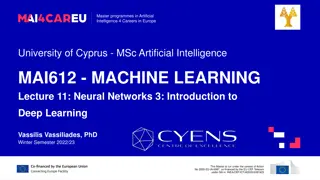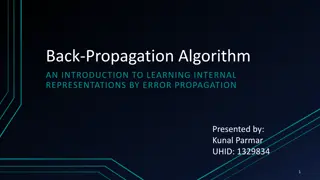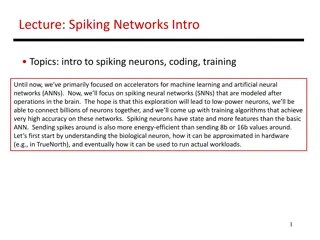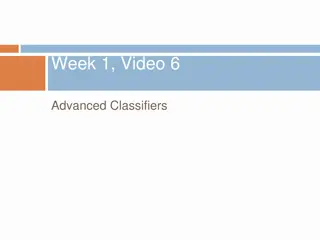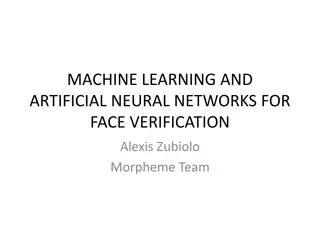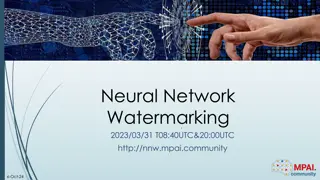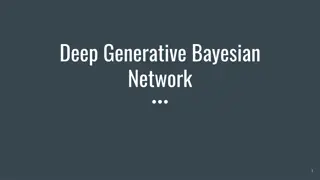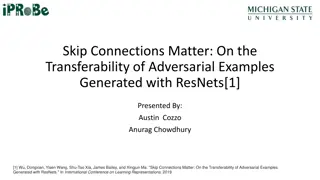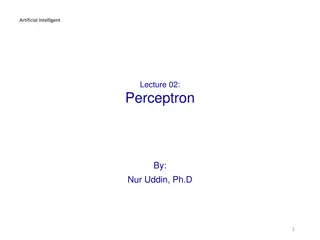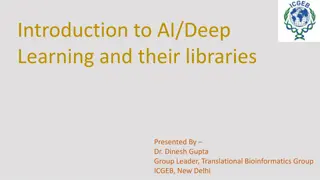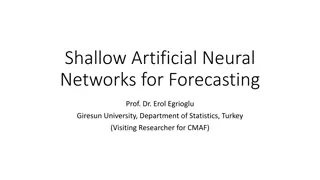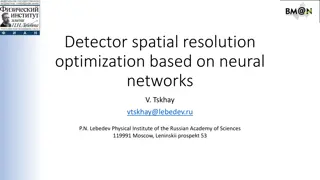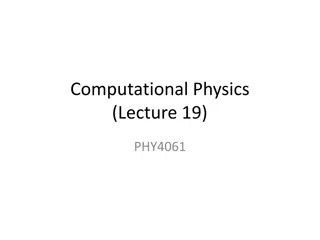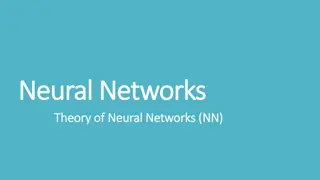The Joy of Finally Learning - Artificial Neural Networks Overview
An informative talk highlighting the core concepts of Artificial Neural Networks (ANNs), including Perceptrons, learning functions, and biological inspirations. Discover the practical applications and workings of ANNs in recognizing patterns like hand-written characters and spoken words. Dive into the world of function approximations and the interconnection of neurons, exploring the birth of error functions and the forward and backward passes in binary classifiers.
Download Presentation

Please find below an Image/Link to download the presentation.
The content on the website is provided AS IS for your information and personal use only. It may not be sold, licensed, or shared on other websites without obtaining consent from the author.If you encounter any issues during the download, it is possible that the publisher has removed the file from their server.
You are allowed to download the files provided on this website for personal or commercial use, subject to the condition that they are used lawfully. All files are the property of their respective owners.
The content on the website is provided AS IS for your information and personal use only. It may not be sold, licensed, or shared on other websites without obtaining consent from the author.
E N D
Presentation Transcript
The Joy of Finally Learning www.mldawn.com
OUTLINE OF THE TALK What is an Artificial Neural Network (ANN)? What is a Perceptron? Bayes Rule and Birth of Error Functions (with Derivations) The Birth of Binary-Cross Entropy Function (with Derivations) Forward Pass and Backward Pass in a Binary Classifier A Demo
WHAT IS A NEURAL NETWORK? An ANN is a function approximator! What is a function? Examples of functions: real-valued, discrete-valued, and vector-valued Applications of ANNs: Recognizing hand-written characters Recognizing spoken words Recognizing faces
WHAT IS A NEURAL NETWORK? Unknown Function !!! ?( ) ? ( ) ??? ? ?(?) Image Cat / Dog (Prob. Vector) ? ( ) ?( ) Stock Information Price ($) (real-valued) Car Information Number (discrete-valued) ANN approximates ?( ) for us
ANN BIOLOGICAL MOTIVATION ANNs are inspired by Biological Learning Systems (BLS) BLS: A massive interconnection of neurons ANNs: Densely interconnected set of simple unites
ANN BIOLOGICAL MOTIVATION For each unit in ANN: Possibly several inputs A Single real-valued output BLS processes are highly parallelized Over nearly 1011 neurons ANNs do NOT fully reflect a BLS Output of neurons are different Researchers try to: 1. Model BLS processes 2. Develop effective ANNs (no regards to BLS compatibility)
SIMPLEST ANN A PERCEPTRON
A PERCEPTRON A type of ANN that is based on a unit called perceptron There is a rule about input/output of a perceptron: Input: A vector of real-valued data Linearly combine the components of the input ?? ?0+ ?1?1+ ?2?2+ + ????> 0 ?? ?????? ? ?1, ,?? = +1 1
A PERCEPTRON What are the weights? What is that ?0? Let s imagine an additional input ?0= 1 This simplifies the inequality: ?=0 ????> 0 Or in vector form: ?. ? > 0 ? Can we show the perceptron smarter? Learning a perceptron = Choosing the weights ? ? = sgn(?. ?) Where: ??? ? = +1 If z > 0 The hypothesis space: ? = ? ? ?(?+1)} 1 otherwise
A PERCEPTRON: A DEEPER LOOK ?0= 1 ?0 ? sgn(?) ?1 ? ?1 sgn(?) ? ? ?1 ?1 ?1
A PERCEPTRON: A DEEPER LOOK ?0= 1 ?0 ?1 ?1 ? sgn(?) ?2 ? ?2 ? ? sgn(?) ?1 ?1 ?1 ?2 ?2 ?2
THE BIRTH OF ERROR FUNCTIONS DO I TRUST MY ANN?
BAYES RULE Let s assume the following notation: M : Our Model D: Our Evidence Then the Bayes Rule: ? ?|? =? ?|? ? ? ? ?
TAKING THE LOGS() : A SIMPLIFICATION ? ? ??? = ??? ? ???(?) ? ?|? =? ?|? ? ? ln? ? ? = ln ? ?|? ? ? ln?(?) ? ? ??? ? ? = ??? ? + ???(?) ??? ? ? = ?? ? ?|? + ?? ?(?) ???(?)
THE BAYESIAN MACHINERY (MAPE) ??? ? ? = ?? ? ?|? + ?? ?(?) ???(?) ???????? ? ? ? ???????? ?(?|?) ??? ? ? = ?? ? ?|? ?? ?(?)+???(?) ???? ?? ??? ????? ???? ???????? ?? ????? ????????? ? = ??? ? ?
MAPE AND ANNS : SUPERVISED LEARNING How can we apply the MAPE to an ANN with weights w? Let s assume that we have a set of examples (di,ti) where di is the i-th input and ti the corresponding target. Then we can rewrite the likelihood as: ? ? ? ??? ? (?? ,??) ? ? ? = ? (??,??) ? ? ? & t ANN ? (??,??) ? = P(ti|di,?) ?(??|?) ?(??)
MAPE AND ANNS : SUPERVISED LEARNING ??? ? ? = ?? ? ?|? ?? ?(?)+???(?) ????? ?????? ????? ??? ??????? ? ? ? ??? ? ?? ??? ???? ??????????? ?? ??? ??????? ?.?????? ???? ?????? ???????????? ??? ? ? = ?? ? ?|? ?? ?(?)+???(?) P(ti|di,W) ?(??) P tidi,W ? ?? ln? ? + ln?(?) ? ??? ? ? = ln ?=1 ln? ? + ln?(?) ? ??? ? ? = ?=1 ln P tidi,W ? ?? ? ? ??? ? ? = ln P tidi,W ln? ?? ln? ? + ln?(?) ?=1 ?=1
MAPE AND ANNS : SUPERVISED LEARNING ? ??? ?? ???? ??? ???????????? ? ?? ????? ??????????? ??? ? ? = ln P tidi,W ln? ? ?=1 ln( ) (? ?)2 2?2 1 ? ? = 2??? 2+ ?1 2+ + ?? 2) (?1 ? ? = ??? ? ? = ln P tidi,W ?=1
BINARY CROSS-ENTROPY ERROR FUNCTION THE DERIVATION
BINARY CLASSIFICATION We have 2 classes: Positive and Negative Binary Classification: ??= 1 means that ?? belongs to the positive class ??= 0 means that ?? belongs to the negative class Artificial Neural Networks (ANNs): Probabilistic approach ANN computes the probability of the Positive Class: ? ??= 1 ??) Could a linear model work? Say, ? = ??? + ? Not Bounded! We need a Squasher!
BINARY CLASSIFICATION ?0= 1 ?0 Input Output [0, 1] ??= 1 ??= 0 ? 1 ?1 ? = ? ? = ?1 1 + ? ? ??????? ... ?? ?? Compute Error Back- Propagation
BINARY CLASSIFICATION The output of our ANN is probability. Let s denote: ??: Probability ?? belongs to the Positive class (i.e., ??= 1) (1 ??): Probability ?? belongs to the Negative class (i.e., ??= 0) ? ????,? = ?? ?? ??= 1 ?? ??= 0 1 ?? Bernoulli Distribution ??(1 ??)1 ?? ? ????,? = ??
BINARY CLASSIFICATION ??(1 ??)1 ?? ? ????,? = ?? ? ? ??(1 ??)1 ??] ? = ln P tidi,W = ln[?? ?=1 ?=1 ? ??+ ln 1 ??] = [ln?? ?=1 ? ? = [??????+ ? ????(? ??)] ?=?
FORWARD PASS ?0= 1 ?0 ? 1 ?1 ? = ? ln? 1 ? ln(1 ?) ? = ? ? = ?1 1 + ? ? ??????? ????? = ? ?(?) = ?(?(?1?1+ ?0)) ? ? Binary Cross-Entropy Error Binary Cross-Entropy Error Function Function
BACKWARD PASS ?? ??1 =?? ?? ?? ?? ??1 ? ?+(1 ?) (1 ?) ?? = ? 1 ? ?1= (? ?) ?1 ?? ??1 =?? ?? ?? ?? ??0 ? ?+(1 ?) (1 ?) ?? = ? 1 ? ?0= (? ?) So the learning rule for both our learnable parameters (i.e., weights) is as follows: ?1= ?1 ? ?? = ?1 ? [(? ?) ?1] ??1 ?0= ?0 ? ?? = ?0 ? (? ?) ??0
www.mldawn.com @MLDawn2018 Mehran Bazargani The Joy of Finally Learning ML Dawn Course Available at: https://www.mldawn.com/course/the-birth-of-error-functions/ Demo s Code: https://www.mldawn.com/binary-classification-from-scratch-using-numpy/


